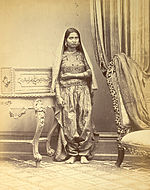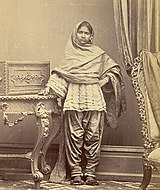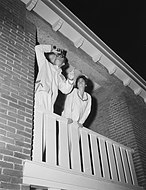Pajamas

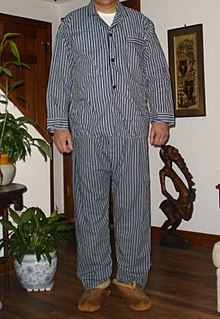
Pajamas (US) or pyjamas (Commonwealth) (/pəˈdʒɑːməz, pɪ-, -ˈdʒæ-/), sometimes shortened to PJs or jammies, are several related types of clothing originating from the Indian subcontinent. In the Western world, pajamas are soft, warm and traditionally loose garments derived from the Indian daywear pajamas and worn for sleeping and lounging by men, women and children.
Etymology
The word pyjama[1] was borrowed into English c. 1800 from the Hindustani pāy-jāma, itself borrowed from Persian: پايجامه, romanized: pāy-jāmeh, lit. 'leg-garment'.[2][3] The original pyjāmā are loose, lightweight trousers fitted with drawstring waistbands and worn by many Indian Muslims, as well as Sikhs and Hindus,[4][5] and later adopted by Europeans during British East India Company rule in India.[6][7]
History

The worldwide use of pajamas (the word and the garment) outside the subcontinent is the result of adoption by British colonists in India in the 18th and 19th centuries, and the British influence on the wider Western world during the Victorian era. Pajamas had been introduced to England as "lounging attire" as early as the seventeenth century, then known as mogul's breeches (Beaumont and Fletcher) but they soon fell out of fashion. The word pajama (as pai jamahs, Paee-jams and variants) is recorded in English use in the first half of the nineteenth century. They did not become a fashion in Britain and the Western world as sleeping attire for men until the Victorian period, from about 1870.[8]
Hobson-Jobson: A Glossary of Colloquial Anglo-Indian Words and Phrases (1886) summarizes the state of usage at the time (s.v. "pyjammas"):
Such a garment is used by various persons in India e.g. by women of various classes, by Sikh men, and most by Mohammedans of both sexes. It was adopted from the Mohammedans by Europeans as an article of dishabille and of night attire, and is synonymous with Long Drawers, Shulwaurs, and Mogul-Breeches [...] It is probable that we English took the habit like a good many others from the Portuguese. Thus Pyrard (c. 1610) says, in speaking of Goa Hospital: "Ils ont force calsons sans quoy ne couchent iamais les Portugais des Indes" [...] The word is now used in London shops. A friend furnishes the following reminiscence: "The late Mr. B—, tailor in Jermyn Street, some on 40 years ago, in reply to a question why pyjammas had feet sewn on to them (as was sometimes the case with those furnished by London outfitters) answered: "I believe, Sir, it is because of the White Ants."[9]
Types
Traditional
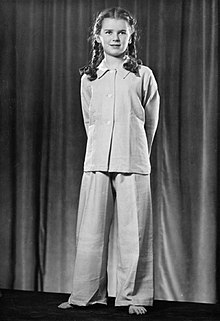
Traditional pajamas consist of a shirt-and-trousers combination made of soft fabric, such as flannel or lightweight cotton.[10] The shirt element usually has a placket front and sleeves with no cuffs.[11]
Pajamas are usually worn as nightwear with bare feet and without underwear. They are often worn for comfort by people in their homes, especially by children, especially on the weekend.
In colloquial speech, pajamas are often called PJs or jammies.[12] In South Asia and South Africa, they are sometimes referred to as night suits.
Contemporary

Contemporary pajamas are derived from traditional pajamas. There are many variations in style such as short sleeve pajamas, pajama bottoms of varying length,[13] and pajamas incorporating various non-traditional materials. Often, people of both sexes opt to sleep or lounge in just pajama pants, usually with a t-shirt. For this reason, pajama pants are often sold as separates. Stretch-knit sleep apparel with rib-knit trimmings are common, mostly with young children.
Although pajamas are usually distinguished from one-piece sleeping garments such as nightgowns, in the US, they have sometimes included the latter or a somewhat shorter nightshirt as a top. Some pajamas feature a drop seat (also known as a trap door or butt flap): a buttoned opening in the seat, designed to allow the wearer to conveniently use a toilet.
Fire safety
In the United States, pajamas for children are required to comply with fire safety regulations. If made of flammable fabric, such as cotton, they must be tight fitting. Loose-fitting pajamas must be treated with a fire retardant.[14] Regulations in the United Kingdom are less stringent; pajamas which do not comply with fire safety standards may be sold, but must be labelled "KEEP AWAY FROM FIRE".[15]
Society and culture
Pyjamas in the Western world have been regarded as essentially indoors wear, or wear for the home, whether treated as daywear or nightwear. But since the late 20th century some people, in particular those in the US and to some extent Britain and Australia, and Polynesians in New Zealand, have worn pajamas in public for convenience or as a fashion statement.[16][17]
In January 2007, the gulf emirate Ras al-Khaimah (part of UAE) introduced a strict dress code for all local government workers forbidding them from wearing pajamas to work.[18]
In January 2010, the Tesco supermarket in St Mellons, Cardiff, United Kingdom, started a ban on customers wearing pyjamas.[19]
In January 2012, a local Dublin branch of the Government's Department of Social Protection advised that pyjamas were not regarded as appropriate attire for clients attending the office for welfare services.[20]
Many school and work dress codes do not allow pajamas.[21]
In Chicago, Illinois, it is illegal to fish wearing pajamas.[22]
A large number of elementary and middle schools in the US designate a "pajama day" when students and staff come to school in their pajamas.
Gallery
-
Girl in short-sleeve pajamas, doll in traditional.
-
Boys in stretch-knit pajamas.
-
Toddler in footed pajamas.
-
Courier in white pajamas, India, 1844.
-
Men in white pajamas with hunting cheetahs, India 1844.
-
Muslim men in pajamas (various styles), Bombay, 1867
-
Hindu woman, in Sind, India, in shalwar-style pajamas, 1870.
-
German advert with genuine English "Schlafanzüge (Pyjamas)", 1910
-
1953 American advert for his and hers day pajamas, I Love Lucy-style
-
Dutch couple come out to watch Sputnik 1 pass, 1957
-
Yves Saint Laurent Rive Gauche, c. 1970 (left), Halston, c. 1976 (right)
See also
References
- ^ "Pyjamas".
- ^ Volo, James M. (19 July 2012). The Boston Tea Party: The Foundations of Revolution: The Foundations of Revolution. ABC-CLIO. p. 51. ISBN 9780313398759.
The word pajama derives from the Hindustani epai-jama.
- ^ Lewandowski, Elizabeth J. (24 October 2011). The Complete Costume Dictionary. Scarecrow Press. p. 216. ISBN 9780810877856.
pajama: (1930-1940 C.E. to present). From the Hindustani word epai-jama, shirt and trouser combination.
- ^ Sharma, Sita Ram. Mohammad Ali Jinnah and Communal Leadership. APH Publishing Corporation. p. 93. ISBN 9788170249351.
Similarly, the sari is the most common dress of women all over India and is worn by both Hindu and Muslim women, and where pyjamas are worn by women as in parts of the north-western region, they are worn not only by Muslim women but by Sikh and Hindu women as well.
- ^ Uttar Pradesh district gazetteers. Government of Uttar Pradesh. 1981. p. 100.
Hindu women in the towns usually wear sari and blouse, while the Jat, Sikh and other Panjabi women wear salwar, kurta and dupatta. In the urban areas, some elderly males, both Hindus and Muslims, are seen wearing churidar pyjamas, achkans (long, buttoned-up coats) and Gandhi caps.
- ^ Oxford English Dictionary 3rd edition, December 2007, s.v.[permanent dead link]
- ^ Omoniyi, Tope (2016), The Cultures of Economic Migration: International Perspectives, Routledge, p. 228, ISBN 978-1-317-03654-8,
But under Muslim rule (in India) ... a variety of sown clothes started emerging .... Muslims introduced pyjamas and kurtas
- ^ Lewis, Ivor. 1991. Sahibs, Nabobs and Boxwallahs: A Dictionary of Words of Anglo-India. Oxford: Oxford University Press. 266 pages. ISBN 0-19-564223-6. "They were introduced in England as lounging attire in the 17th century but soon went out of fashion. About 1870 they reappeared in the Western world as sleeping attire for men, after returning British colonials brought (them) back ...." Encyclopædia Britannica. Retrieved December 29, 2006, from: Encyclopædia Britannica Online.
- ^ Yule, Henry and A.C. Burnell, Hobson-Jobson: A Glossary of Colloquial Anglo-Indian Words and Phrases (1886), s.v. Pyjammas, p. 748. Hobson-Jobson glosses "white ants" as "The insect (Termes bellicosus of naturalists) not properly an ant, of whose destructive powers there are in India so many disagreeable experiences, and so many marvellous stories."
- ^ "Girl sitting on bed and wearing striped flannel pajamas and Disney Donald Duck slippers."[permanent dead link] Life magazine, December 1949, (Photographer: Nina Leen).
- ^ "Millionaire Charles Ponzi posing for photograph in pyjamas."[permanent dead link] Life magazine, 1942, (Photographer: Hart Preston).
- ^ "Three college students wearing their PJs and playing in the bunk bed of their dorm room during rush week at the University of Illinois"[permanent dead link], Life magazine, September 1956 (Photographer: Grey Villet).
- ^ "Harriet Traynham (R) and her guests still wearing their pyjamas at 3:15 pm,"[permanent dead link] Life magazine, August 1951 (Photographer: Lisa Larsen)
- ^ "Children's Sleepwear Regulations". CPSC.gov. 2016-07-16. Retrieved 2020-01-15.
- ^ "Children's Clothes and Fire Safety". www.safekids.co.uk. Retrieved 2020-01-15.
- ^ "Now they're shopping in pyjamas in Shanghai!" Liverpool Echo, 17 January 2009. Retrieved 1 May 2015.
- ^ Helen Pidd (2010-01-28). "Tesco bans shopping for bananas in pyjamas ... or bare feet". the Guardian.
- ^ "BBC NEWS - Middle East - Pyjama ban for UAE civil servants". 2006-12-21.
- ^ "Tesco ban on shoppers in pyjamas". BBC News. 2010-01-28. Retrieved 2013-01-23.
- ^ "Meanwhile, In Blanchardstown". Broadsheet.ie. 2012-01-24. Retrieved 2013-01-23.
- ^ "Vt. high school dress code now bans pyjamas[permanent dead link]" Retrieved on April 15, 2012
- ^ Fishing with pajamas
External links
- Gao Yubin, "The Pajama Game Closes in Shanghai". The New York Times. May 14, 2010. Accessed May 18, 2010.







